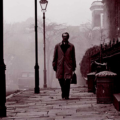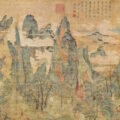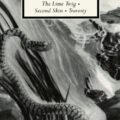Conversations: Chloe Aridjis and Chloe Garcia Roberts

I am a fanatic believer in the serendipity of found books. A few years ago, while working in the Woodberry Poetry Room at Harvard, I was straightening up before heading out for the day and found Chloe Aridjis’s first novel, Book of Clouds, abandoned on one of the tables. That very same week I had been working on cataloguing a reading she gave with her father, the renowned Mexican poet Homero Aridjis, while she was still an undergraduate. Intrigued by the coincidence, I took the book home, read it, and loved it. I found out her second novel, Asunder had just been published, and I devoured that one as well. Then when her translation of her father’s autobiographical novel, El poeta niño / The Child Poet, came out earlier this year (a project that began back when that recording I had been researching was made), I reached out to interview her about her novels, her translation, and her relationship to her father’s writing. This interview took place over a series of email exchanges earlier this year.
—Chloe Garcia Roberts
Chloe Garcia Roberts: The Child Poet is your translation of your father’s work El poeta niño, a work that, as you mention in your introduction, was begun just months before your birth, when the memories that comprise the novel came flooding back to your father. I am always interested in the question of responsibility when it comes to translation: to what degree the translator negotiates fidelity and creation and how they escape the gravity of the original text in order to answer it in another language. Could you tell us about your particular responsibility to this text is as both its translator and catalyst?
Chloe Aridjis: The Child Poet was written while my mother was pregnant with me so it almost feels like my spiritual twin. It’s also one of my father’s books that is most dear to me. I was aware, too, that not a great deal of my father’s work existed in English, so this book had to be representative of a larger oeuvre. For these reasons the weight of responsibility was heavy, and the stakes felt particularly high. As the author’s daughter and, as you say, catalyst, I worried at moments that I didn’t have enough distance from the text, but in the end I think it benefited from the proximity.
They say that in order to translate a text one must internalize it first, in order to fully transmit the spirit of the original, and I’d certainly done that before embarking. In terms of fidelity, there were very few instances where I felt I was being “unfaithful”—and when I did stray, it was nearly always for the sake of rhythm. I occasionally fused sentences, especially shorter ones that began with “Y.” Certain words felt very reduced in English—CERRO for instance, such an important feature of my father’s early geography, was untranslatable. In Spanish cerro is somewhere between monte and montaña, but in English there’s no real equivalent—it’s larger than a hill but smaller than a mountain—and there’s little that’s evocative in the word “hill”; its physical presence doesn’t come across at all. But in the end I decided on this word and for some reason it feels like one of the main compromises I had to make!
CGR: In the last section of your translation of The Child Poet (“The Solitary Enchanter”), the line “Between the childish face and my aunt’s present aspect, there had been a fearful gust of wind: time,” with its direct instead of sidelong acknowledgement of the force and density of time, resonated for me not just in connection with the rest of the text itself, but on another level, with your translation of it. The Child Poet is a book about your father’s memories, but it is also about the substance of the past, its atmosphere, its attributes, the way life refracts through it, or reflects off of it, and how it is interwoven and inseparable from the self. In your introduction you mention that you began the translation of this text while an undergraduate at Harvard, before embarking on your own writing career, and finished after the publication of your second novel, Asunder. I wonder if you would talk about these layers of time in your translation, in your relationship with the text, and in the text itself.
CA: I sometimes wonder how different the result would have been had I finished the translation when I first started it in 1993, rather than over twenty years later, once I’d written two novels of my own. I tried to remain as unintrusive as possible and not succumb to certain writerly instincts that have inevitably developed since then. Spanish is the language of my own childhood and especially adolescence; English is more associated with my adult life (my studies were in the US and UK, I live in England, write in English), so there was a kind of translation taking place at other levels too, and I had to reach into my own past and reinhabit a world that existed purely in Spanish—and of course the vanished world of my father’s childhood, since Mexican villages have undergone all sorts of transformations too. Donkeys have been replaced by cars, every home has a television, every family has someone who’s gone off to seek fortune in Mexico City or the US.
Within the book itself, time exists in wonderful and mysterious forms. The adult poet is looking back on his childhood self, on all the moments and impressions that fed into his poetic awakening. This heightened observation and introspection is delivered in vignettes. Vignettes tend to create a temporal slippage; one has the sense there’s something aleatory about their order, and yet these fall into a very careful rhythm, and I’m sure my father thought deeply about cadence and sequence when composing the book. I know he read all of Proust in his twenties, shortly before starting to write The Child Poet.
CGR: It is interesting that you bring up Proust because in turning to your novels, there is a very different temporal cadence mapped out. Instead of following a narrative of understanding the present as an accretion of the past, your protagonists in both Book of Clouds and Asunder seem to grow concentrically outward from the present moment, slowly spilling out into their pasts and futures. In order to inhabit the temporal layout of these two very different novels, I was forced to adopt a different relationship with time, to stop forecasting a future arc and stop waiting for the context of a past. As your protagonist states in Asunder, “I have always been more interested in being than becoming.” As a result of this focus on the immediate, we get to know the two women in the way we know anyone—incompletely and in fragments. I’d love to hear more about the thinking behind your structuring of the foreground and background of a character’s life.
CA: It’s true, I tend to shy away from lengthy backstories. Often they can feel like too much of an authorial presence and also I prefer to preserve some mystery and limit the amount of exposition. And as you point out, in reality the particulars of any individual’s life are parceled out in fragments, of which many are forever withheld.
In Book of Clouds, Tatiana’s solitude and alienation shape the narrative. She suffers a disconnect from everything around her and tries to distance herself from the past—both her own and the city’s—until she starts working for the historian Dr. Weiss. Then everything changes and her mental state becomes increasingly entangled with certain elements of Berlin’s history. The city’s past is so forceful that it can’t help but constantly intrude—the challenge was how to cut back and forth between the two protagonists, Berlin and Tatiana, and grant them equal space to develop. The novel is loosely structured around the themes of her research, since each one leads to a new adventure or revelation.
In Asunder I considered the narrator’s profession as museum guard at the National Gallery and how different narratives coexist in the paintings of the rooms and likewise in her head—they end up inhabiting the same temporal plane, a kind of seamless present. Marie focuses on what’s before her but on the background, too, intrigued by present moments in the museum but also haunted by its past. And the motif of craquelure can be seen to embody the different threads in the novel or the cracks in a painting that eventually link up, real and potential releases of tension, tiny ruptures or fissures that indicate a moment of crisis. That’s where new meaning surfaces, and new insight into the past. I prefer to work this way, to set up a little landscape and see where it might crack.
In both novels the female protagonists go from being passive observers of the worlds around them to acquiring more agency over their lives. Marie is the more nostalgic one and reaches often into her own past. Tatiana on the other hand almost negates her years in Mexico and immerses herself entirely in Berlin; real life starts there.
CGR: Both of these novels are rife with poetry. There are poetic elements, such as the secret tunnels of Berlin, the phenomenon of craquelure, Marie’s miniature landscapes, dream cats, just to name a few, and repeated references to poets both living and fictionalized. What role does poetry play for you as a novelist who is the daughter of a poet?
CA: I grew up surrounded by poets, and it’s probably the calling I most admire, especially in these times. I met many as a child—my parents organized three international poetry festivals in the ’80s—and then as an adolescent I became a reader of poetry. And now when I write, I often return to certain poets (especially Miroslav Holub and Zbigniew Herbert, for some reason), in order to enter a particular zone. It’s that rare act of distillation and the poet’s oblique vision of the world.
As I near the final stages of a novel I suddenly become aware of correspondences that exist between the themes and also of a larger metaphorical framework, which I’ve half set up and half of which happens on its own. That’s when I start to feel everything is working. It sometimes helps to envision the text as one very long prose poem.
CGR: You speak of a scrim between your past in Mexico and your relationship with Spanish and your present in England and your relationship with English as a divide that had to be negotiated in your translation. As a reader, I could feel a similar divide between the past and present in your novels. With Book of Clouds in particular, a book about an expatriate in Berlin, the main character, Tatiana, carries the burden of home and past surprisingly lightly. I kept waiting for the oblique references to her life and family in Mexico to be brought to the forefront to contextualize her present, but this never happens. The past exists independently, afar. As an author, where is your artistic home?
CA: That’s a difficult question to answer! I guess I’d say a vague Europe (and for me, England will always belong to and in Europe). Ever since I was an adolescent most of the writers and painters who left their mark on me most deeply hailed from France, Germany, or England. Some too from Latin America, Russia, and Eastern Europe, but predominantly from those first three countries. If I had to choose a city, however, it would definitely be Berlin—I still feel a strong tropism towards the place whenever I sit down to write. It’s the city itself, so strange, tense, and layered (though alas some of its strangeness has vanished) and my own associations with the place, especially the two summers I spent there as an adolescent, right before the Wall came down, and the tremendous spell they cast.
CGR: And, finally, could you tell us about what you are working on now?
CA: I’ve just finished my new novel, set in Mexico in the late ’80s, and am now working on a short story about my cat from Hydra. I hope to start the next novel, about moths and magic lanterns, this autumn.
Chloe Aridjis grew up in the Netherlands and Mexico. She then studied comparative literature at Harvard followed by a PhD at Oxford in nineteenth-century French poetry and magic shows. Her first novel, Book of Clouds, won the Prix du Premier Roman Etranger in France in 2009. Her second novel, Asunder, is set in London’s National Gallery. Chloe was the recipient of a Guggenheim Fellowship in 2014. She recently co-curated the Leonora Carrington exhibition at Tate Liverpool. Her third novel is due to appear in 2017. You can read her writing on Baudelaire and prose poetry online at The Independent.
Chloe Garcia Roberts is the author of The Reveal (Noemi Press) and the translator of Li Shangyin’s Derangements of My Contemporaries: Miscellaneous Notes (New Directions), which was awarded a PEN/Heim Translation Fund Grant. Her work has appeared in the publications BOMB, Boston Review, A Public Space, and Interim Magazine among others. A collected poetry of Li Shangyin is forthcoming from NYRB Books. She lives in Boston and is managing editor for Harvard Review.
Top Photo: Homero Aridjis Writing The Solitary Enchanter with Chloe Aridjis in His Arms.





